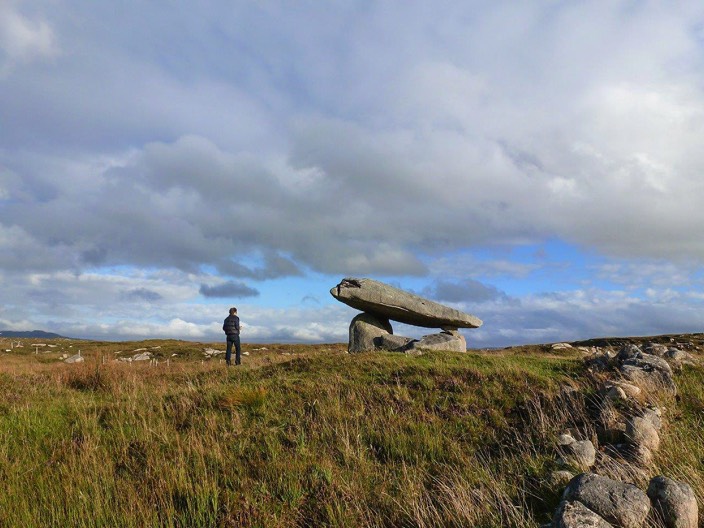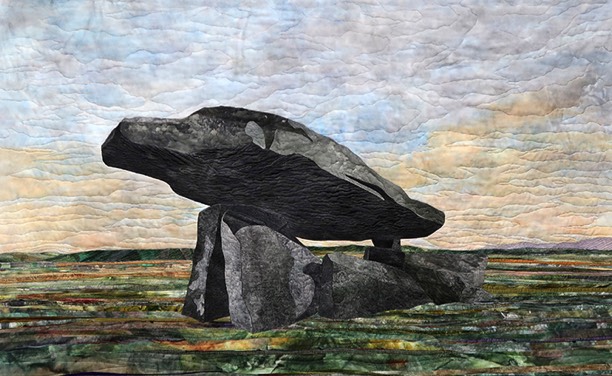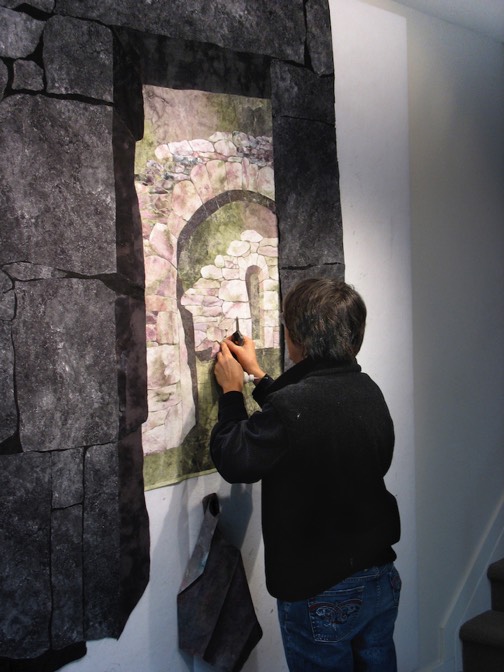I am drawn to megalithic – particularly Celtic – stones, their landscapes, and their stories. I have come to similarly revere more recent monastic ruins (especially portals and passageways).
It was while planning a second visit to Ireland – my great grandmother came to the US from Ireland, and my initial visit had affirmed a deep connection that I needed to follow up on – that I first saw a picture of the Piper Stones, a stone circle in Co. Wicklow, that sent shivers through me. I immediately sought them out when I returned. These stones – and later, many others, such as the Kilclooney Dolmen pictured below – “talk to me”, and I’ve focused ever since on finding and visiting new stones (both in and beyond Ireland) and using my art to try to convey the essence of these whispered communications.

Denise with the Kilclooney Dolmen, Co. Donegal, Ireland

Kilclooney Dolmen, 2016
58" wide x 35" high (147 x 90 cm)
My quilts often evoke strong feelings and emotions. Several have been purchased as meditation tools, as catalysts for focusing and healing. They touch on a number of universal themes: stability, permanence and continuity, and the timeless hopes and dreams of their builders. It’s almost as if the quilts jostle some deep core of cellular memories, helping viewers remember what they already intuitively know and honor, but may have set aside or forgotten. My quilts seem to surface a range of experiential remembrances.
I grew up loving to sew, and loving to work with and hold fabric, and I turned that focus into a business as an adult. Working as a professional seamstress, though, only heightened my longing to combine my sewing “craftsmanship” with greater levels of creativity.
When I discovered and decided to pursue art quilting (in the early 1990's), I had little background or formal training in art. I thus developed and followed a deliberate plan to acquire “the basics”. Before I produced my first art quilt, I took not only "how to" quilting classes, but also selected design and art classes that covered key topics that I knew I needed to better understand – drawing, painting, composition, color, perspective, shadowing, and the like.
I also sought out and joined a very supportive, insightful, multi-discipline, and mentoring artist critique group; they have had (and continue to have) a huge positive influence on both me and my art.
At the same time, I was very lucky to have an incredible local contemporary quilt guild (300 members) here in Northern Colorado, where I was both warmly welcomed – even as a relative novice and newcomer – and where I was able to meet and take additional classes from many very accomplished local and visiting art quilters.

My quilting style – a moody realism based on the strong and assertive use of perspective, high contrast, texture, shadowing, and light management – began to take root. Stones and ruins became my passion, my approach to quilting gained focus, and my love of both art quilting and fabric continued to grow.
I use a wide variety of colors, fabrics, threads, and yarns in my work, and then construct the actual quilt the same way as a stone mason builds a wall – individually sizing and cutting out, piecing, and appliquéing each stone, one by one, working from the bottom up – each stone a foundation for the others that it supports or neighbors. In contrast to the realism of the stones, my skies and landscapes – which are central to the context of place and the timelessness of these sacred sites – are far more abstract.
I hand paint almost all my fabric (from which – as described above – I then individually cut out each stone). The realistic color and texture of my stones is achieved by using multiple layers of sun-reactive transparent Seta color paints, plus various resists, in combination with (while wet) the aggressive folding, twisting, wrapping, bunching or pleating of the fabric, and (while drying) the application of sand, different types of salt crystals, sugar, dirt, and the like – basically, doing or using most anything that can influence or cause differential paint absorption, diffusion, blending, patterning, or mottling. Resulting fabrics can be remarkable.
I then use selective combinations of multiple appliqué techniques (reverse, turned edge, and raw edge), insetting, and free-form strip piecing / couching – plus an occasional very localized dab of paint – to achieve my trademark quilt top textures, lighting, depth of field, and shadowing and perspective. Throughout, full attention is given to proper craftsmanship, “sweating the details”, and technique precision.